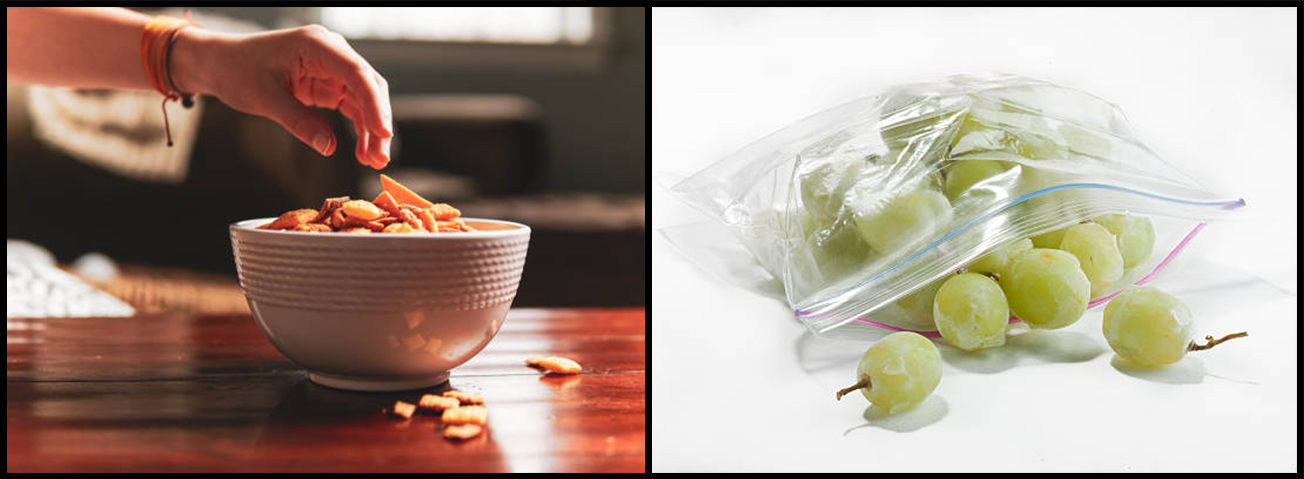
Grazing Increases Daily Caloric Intake and Dietary Quality
- by Eliana Zeballos and Carolyn Chelius
- 3/7/2022
Dietary advice typically focuses on what and how much to eat. However, there is evidence that suggests frequency of eating also may affect dietary quality. “Grazing” is a common dietary pattern characterized by the continual ingestion of calories throughout the day. USDA, Economic Research Service (ERS) researchers investigated whether grazing affects total daily caloric intake and dietary quality as measured by USDA’s 2015 Healthy Eating Index (HEI-2015). The Healthy Eating Index gauges diet quality by measuring how well a person’s diet conforms with recommendations in the Dietary Guidelines for Americans.
The HEI-2015 is made up of 13 dietary components encompassing food groups such as fruit, dairy, or whole grains and dietary elements such as fatty acids, empty calories, or sodium. The Healthy Eating Index sums to a maximum score of 100, and a higher score reflects better diet quality. The score includes nine “adequacy” components (including whole fruits, vegetables, and whole grains), for which higher consumption raises scores. The score also contains four “moderation” components (including refined grains and added sugars), for which lower consumption raises scores. ERS researchers defined grazing as eating more than 3 times a day and used 2 days of U.S. adult food intake data from the National Health and Examination Survey (NHANES) from 2007-18. These data capture detailed information about the types and amounts of food consumed in 2 non-consecutive days, as well as when each food was eaten.
Using 2 days of intake for each survey respondent, the researchers controlled for individual characteristics that do not change across the 2 days, including demographic variables such as gender and unobserved food and eating preferences, such as choosing items to avoid food allergies. The researchers then were able to estimate how changes in day-to-day eating patterns, such as grazing, affect calories consumed and diet quality.
The results show grazing increased total daily caloric intake by 205 calories and increased the daily HEI score by 0.59 points. Grazing increased HEI component scores for total fruit, whole fruit, and refined grains, and decreased HEI component scores for saturated fats.
Researchers also observed how dietary quality differed between morning and evening grazers. Individuals were defined as morning grazers if they reported more than two eating occasions between 3 a.m. and 2:59 p.m. Compared with people who did not graze at all, morning grazers increased their total daily caloric intake by 159 calories and increased the daily HEI score by 0.87 points. The HEI score rose because morning grazers ate more total fruit, whole fruit, whole grains, total dairy, seafood, and plant proteins and consumed less sodium. Individuals were defined as evening grazers if they reported more than one eating occasion between 3 p.m. and 2:59 a.m. Compared with not grazing, evening grazing increased daily caloric intake 76 calories and decreased the daily HEI score by 0.41 points. Evening grazers decreased the component scores for total fruit and whole grains, suggesting they consumed less of those foods. They also decreased their HEI score for fatty acids and saturated fats by consuming more of those two components. However, evening grazing increased HEI scores for sodium and refined grains, meaning consumption was lower for those components.
While grazing can increase daily caloric intake and dietary quality, factors such as the time of day may make a difference. Because dietary quality is dependent on the foods consumed and the nutrients in need of increasing or decreasing, it is important to understand how factors such as time of day can influence food choices.
This article is drawn from:
- Zeballos, E. & Chelius, C. (2021). "The Effects of Grazing on Daily Caloric Intake and Dietary Quality" . International Journal of Behavioral Nutrition and Physical Activity . (18) No. 1: 1–14.
You may also like:
- Diet Quality & Nutrition. (n.d.). U.S. Department of Agriculture, Economic Research Service.
- Food Choices & Health. (n.d.). U.S. Department of Agriculture, Economic Research Service.
- Zeballos , E. & Todd, J.E. (2020, July 6). Skipping Breakfast or Lunch Has a Larger Impact on Diet Quality Than Skipping Dinner. Amber Waves, U.S. Department of Agriculture, Economic Research Service.


